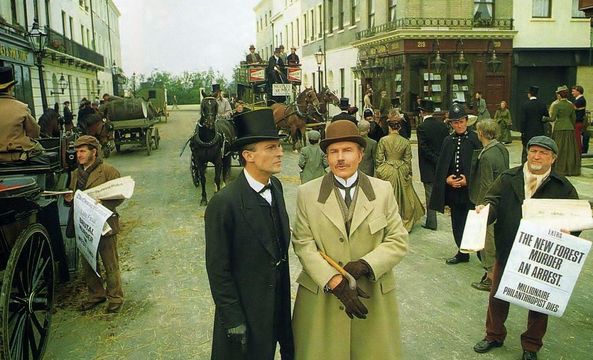
A promo shot for the latests reincarnation of Sherlock Holmes, in 1984, by Granada TV.Granada
Here we look at Sherlock Holmes London and the life of his creator.
The Adventures of Sherlock Holmes and his faithful companion Dr. Watson continue to grip readers and TV fans alike. Across the Victorian cityscapes of yellow-fogged, gas-lit London and England’s wild, Gothic countryside, the game was always afoot for Holmes and Watson.
“How are you? You have been in Afghanistan, I perceive.” Within a flash of being introduced to Dr. John Watson, Sherlock Holmes, “the most perfect reasoning and observing machine,” has looked him up and down and drawn a conclusion.
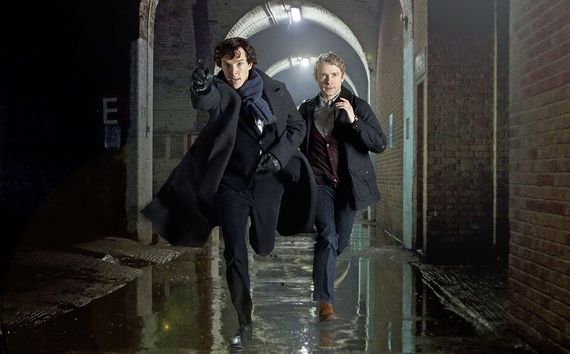
Promo shot for BBC's Sherlock.
The sleuth’s methods of deduction, first displayed in A Study in Scarlet in 1887, rarely failed him in four novels and 56 short stories—allowing him to conjure whole case histories from the appearance of fingernails, trouser-knees and other seemingly trivial details.
One hundred and fifty years after Holmes’ creator, Sir Arthur Conan Doyle, was born, the workaholic, hawk-faced “consulting detective” with a penchant for violins, morphine, and cocaine, remains an icon of English literature. (Fervent Sher-lockians insist that Doyle was merely the literary agent in the set-up, while the slightly dim-witted Watson played Boswell to Holmes’ Johnson.) Doyle’s tales were not the first modern detective stories, but they helped to pioneer an infant genre and set a benchmark for so many colorful English detectives that followed, from Agatha Christie’s Poirot to Ian Rankin’s Rebus.
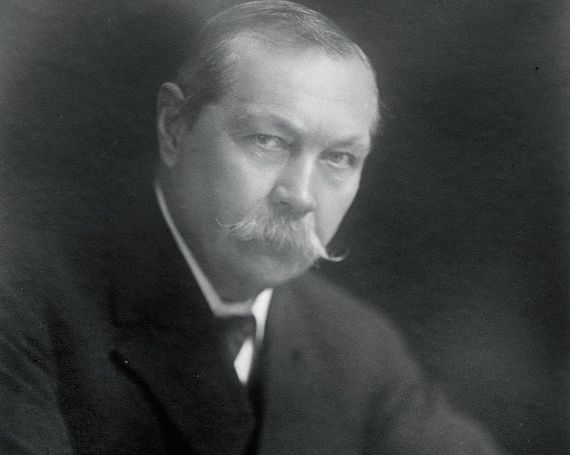
Edinburgh-born Sir Arthur Conan Doyle (1859-1930) penned historical novels, science fiction and works on spiritualism during his prolific careeer. His enduring fame, however, rests on the inscrutable “consulting detective,” Sherlock Holmes.
Inspired by Edgar Allan Poe’s detective Dupin and the neat dovetailing of plots in Emile Gaboriau’s M. Lecoq tales, Doyle added the “science” of detailed observation and classification that he had learned as an Edinburgh medical student: An innovation perfectly in tune with the progressive, Darwinian age. Readers became hooked by the briskly moving, tight puzzles, and the Holmes-Watson double act. Sherlock was no prosaic “Plod”; he was a pipe-smoking aesthete with a cool, creative touch:
“Is there any other point to which you would wish to draw my attention?” asks the inspector in “The Adventure of Silver Blaze,” the Dartmoor-based tale of a vanished racehorse.
“To the curious incident of the dog in the night-time,” Holmes replies.
“The dog did nothing in the nighttime.”
“That was the curious incident.”
Such laconic exchanges have fans gleefully throwing their deerstalker hats in the air. Equally memorable are the stories’ Victorian landscapes of yellow-fogged, gas-lit London, dashing hansom cabs and England’s wild, Gothic countryside.
Come, Watson, come, the game is afoot: Though times have changed, you can still walk in the footsteps of Doyle and his sleuth, indeed a whole niche tourist industry has grown around doing just that.
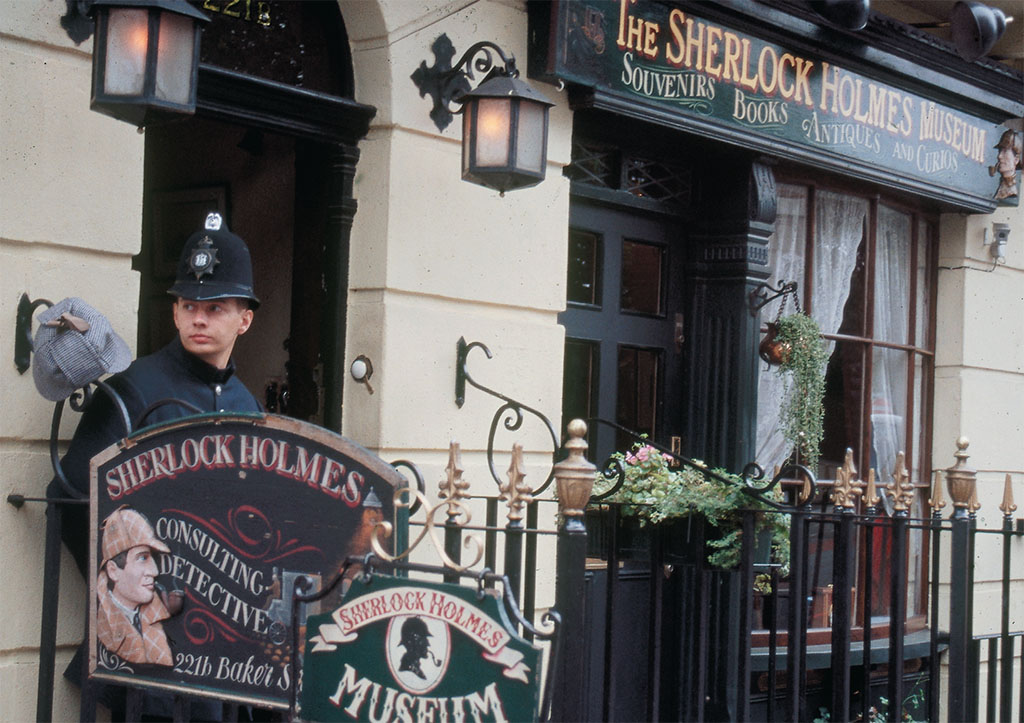
Famous 221b Baker Street never really existed. For years, the bank where it should have been employed someone to answer Holmes’ voluminous correspondence. Now, the Sherlock Holmes Museum borrows the address. (Dana Huntley)
First stop is London, where a statue of Holmes outside Baker Street underground station welcomes travelers. Look up the world-famous address 221b Baker Street, where Holmes shared rooms with Watson, or at least the Sherlock Holmes Museum that has taken the address and evokes his residence with atmospheric detail (www.sherlock-holmes.co.uk).
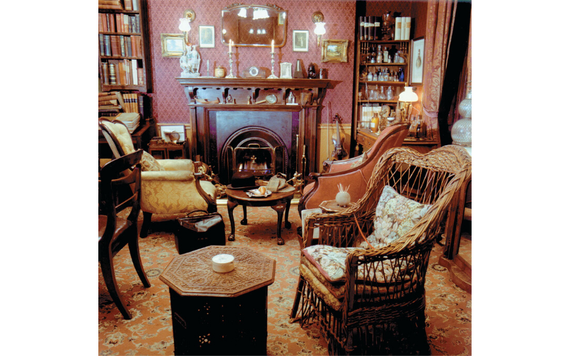
Inside the Sherlock Homes Museum.
You can also join Original London Walks, which does a popular trade in guiding visitors to scenes of Sherlockian significance: Charing Cross where Holmes caught a spy, the alleys of the Strand, Covent Garden where the Christmas goose was procured in “The Adventure of the Blue Carbuncle” and so forth (www.walks.com).
Investigations reach a fitting conclusion at The Sherlock Holmes pub and restaurant on Northumberland Street, formerly the hotel in which Sir Henry Baskerville stayed when he came to claim his inheritance in The Hound of the Baskervilles. Menus feature Doylean dishes like “A Scandal in Bohemia” duck and you can view a recreation of Holmes’ study and sitting room, plus other artifacts: Including copies of Sidney Paget’s noted illustrations from the Strand Magazine which serialized the Sherlock Holmes tales (www.sherlockholmespub.com).
Away from London, wander Groombridge Place Gardens & Enchanted Forest in Kent. When Doyle lived close by, at Crow-borough, he frequently came to take part in séances at the 17th-century moated manor house, and in The Valley of Fear (1915) Groombridge becomes Birlstone Manor, the scene of murder: The only approach to the house was over a drawbridge across a “beautiful broad moat, as still and luminous as quicksilver in the cold winter sunshine.”
Farther afield, Britain’s last southern wilderness, Dartmoor in Devon, beckons as the stage for the eerie tale of the spectral hound of the Baskervilles. Doyle visited in 1901 with a journalist friend, Bertram Fletcher Robinson, who had regaled him with legends of a phantom hound that ranged the moor close to his family seat at Ipplepen.
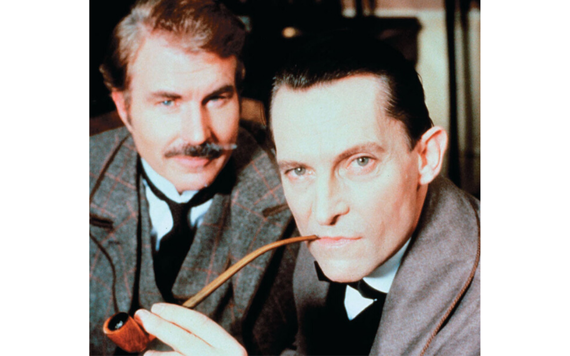
Basil Rathbone and Nigel Bruce, possible the most famous pairing of Dr. Watson and Sherlock Holmes.
Doyle stayed at the Duchy Hotel in Princetown—now the High Moorland Visitor Centre, complete with Holmes display—looking towards the grim hulk of Dartmoor Prison. The Bronze Age settlement of Grimspound and treacherous Fox Tor Mire transformed into the novel’s prehistoric huts and Grimpen Mire where one false step spells “death to man or beast.” Watson’s fearful impressions of the barren scene, cut through by the fantastic shapes of Belliver and Vixen Tor, imprinted Dartmoor’s brooding landscape on a million imaginations.
Incidentally, the Robinson’s coachman was called Harry Baskerville, but that could be a red herring: Herefordshire also claims to have been a source of inspiration for the tale with its black demon dog of Hergest Court, a place Doyle visited, and the Baskervilles of Eardisley Castle.
And what of Arthur Conan Doyle himself? The burly, moustachioed author stands almost hidden in the giant shadow of Sherlock Holmes, and his other works—he was a prolific writer, of historical novels, science fiction, wartime chronicles, theater, spiritualist essays, and campaigning pamphlets—always suffered by comparison. Doyle became so disenchanted with his detective’s fame that he killed him off at the height of his popularity in “The Final Problem” (1893). He called it “justifiable homicide,” but the public was in an uproar. Doyle reluctantly had to revive him.
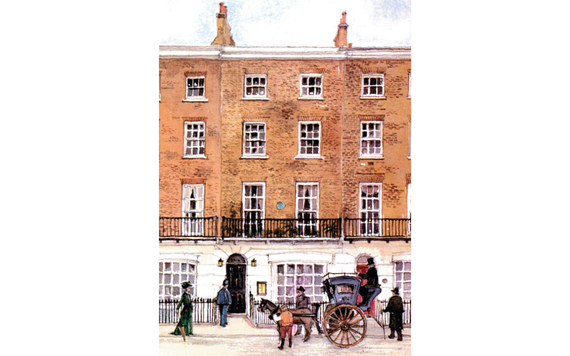
This lively watercolor of 221b Baker Street, complete with hansom cab, imaginatively evokes Victorian London.
Arthur Ignatius Conan Doyle was born May 22, 1859, in straitened circumstances at 11 Picardy Place in Edinburgh, the second of 10 children of whom seven survived. Creativity flowed in the Doyle blood: His Irish grandfather, John, was a pioneer of political caricature and his uncle Richard was a famous cartoonist and illustrator. His father Charles, though, was a failed architect and alcoholic who would die in a mental hospital, a tragic life that Arthur later glossed over with references to a “dreamy aesthetic figure.” On the subject of his Irish mother, Mary (née Foley), he was lyrical: She gave him a love of history, particularly of medieval chivalry, and storytelling, inspiring him to avid reading, from Mayne Reid to Poe, Bret Harte to Jules Verne, Swift to Macaulay. Throughout his life, he would regularly write letters to “Mam,” many of them are now held at London’s British Library.
Arthur’s Doyle uncles financed his schooling at the Jesuit Stony-Hurst College in Lancashire where he developed a lifelong passion for cricket and told stories to the younger children in return for pastries. Then it was back to Edinburgh and university to study medicine, interspersed with much-needed money-earning jobs. By a quirk of fate, J.M. Barrie of later Peter Pan renown and Robert Louis Stevenson were students here during Doyle’s time, but he never met them. He did encounter his model for Sherlock Holmes, the amazing lecturer Dr. Joseph Bell, whose deductive powers in sizing up patients from their behavior, physiognomy, accent, and clothing were legendary.
However it was to be a while before the sleuth appeared, and Doyle’s first foray into print was with the treasure hunt in South Africa, “The Mystery of Sasassa Valley,” 1879. The short story earned the 19-year-old three guineas from the Edinburgh magazine, Chambers’s Journal, and from that moment he was “a beast that has once tasted blood.”
Doyle marked the completion of his medical studies in 1881 with characteristic humor, drawing a sketch of himself with his diploma and the caption: “Licensed to Kill.” (The prediction would come true in the fictional sense at least.) His outward ebullience nevertheless masked inner struggles, for by now, gorged on a diet of scientific training and Darwinism, he had lost his Catholic faith and was an agnostic; the void would be filled eventually by spiritualism.
Our trail next heads to Plymouth, where Doyle joined his former classmate George Budd in medical practice for a short, unsuccessful period (an experience reflected in The Stark Munro Letters, 1894), before setting up in independent practice at 1 Bush Villas in Elm Grove, Southsea 1882-90. Through sheer hard work and networking, he succeeded, and also managed to court and marry a patient’s sister, Louise Hawkins, in 1885.
To fill the initially long waits between patients, Doyle had thrown himself into writing. His first Sherlock Holmes story, A Study in Scarlet, was dismissed by three publishers before it appeared in Beeton’s Christmas Annual 1887. When Doyle introduced Watson to Holmes at St. Bartholomew’s Hospital in London and set them to investigate a murder, he had no plans to make the duo a permanent fixture. But the die was cast when Joseph Marshall Stoddart, managing editor of (the U.S.) Lippincott’s Monthly Magazine, invited him to dinner at London’s fashionable Langham Hotel, Portland Place, 1889. The resulting commission saw Doyle pen The Sign of Four (1890), while his fellow guest at dinner, Oscar Wilde, wrote The Picture of Dorian Gray (apparently the two writers got on like a house on fire).
Anyone with a grasp of American geography will spot Doyle’s shortcomings in the flashback sequence to Utah in A Study in Scarlet. In The Sign of Four it’s the mystery of Watson’s peripatetic war wound that intrigues. Doyle was never such a stickler for detail as Holmes, and for puzzle-loving Sherlockians such anomalies seem part of the novels’ fascination.
On an impulse, Doyle went to Vienna in 1890 to pursue studies of the eye, and in the following year he moved to London, but his efforts to establish himself as an ophthalmologist in Upper Wimpole Street never got off the ground. Instead, he turned full time to writing. Security was assured when from 1891 he began contributing short stories to the Strand Magazine, later collected as The Adventures of Sherlock Holmes (1892) and The Memoirs of Sherlock Holmes (1894).
To outward appearance life seemed perfect: The family moved into a redbrick house at 12 Tennison Road, South Norwood, south of the Thames. Two children, Mary (1889) and Kingsley (1892), suggested a contented marriage. When Arthur wasn’t churning out Holmes tales, he was busier than ever socializing and playing sport. Through the boisterous Idlers Club, he became friends with the likes of Jerome K. Jerome of Three Men in A Boat fame and J.M. Barrie, whose Allahakbarries cricket team he joined. His speaking tour to America in 1894 proved popular—what U.S. audience wouldn’t like an author whose detective says in “The Noble Bachelor,” “It is always a joy to meet an American” and expresses the wish that someday the two nations’ children will be “citizens of the same world-wide country under a flag which shall be a quartering of the Union Jack with the Stars and Stripes.”
But life was not all rosy for Doyle. After the runaway success of two series of Holmes stories, he deeply resented being identified solely with what he called “a lower stratum of literary achievement.” So in “The Final Problem” he sent Holmes and the “Napoleon of crime,” the notorious Professor Moriarty, apparently plunging to their deaths at Reichenbach Falls in Switzerland. Following the story’s publication in the Strand, December 1893, 20,000 readers cancelled their subscriptions. Newspapers carried reports of the detective’s untimely demise—some people believed he was a real person. Doyle was unrepentant.
So what were the author’s greater literary concerns? As early as 1889 he had announced his quest to write the great British historical novel with the publication of Micah Clarke, an adventure of a young man who joins the Duke of Monmouth’s 17th-century rebellion against King James II. It was well-received, and he followed up with The White Company (1891) featuring three Hampshire bowmen in the Hundred Years’ War. Disappointed that critics treated this effort as “a mere book of adventure” rather than the painstaking study he had intended, he nevertheless ploughed on with further historical tomes, including Rodney Stone (1896), The Exploits of Brigadier Gerard (1896) and Sir Nigel (1906).
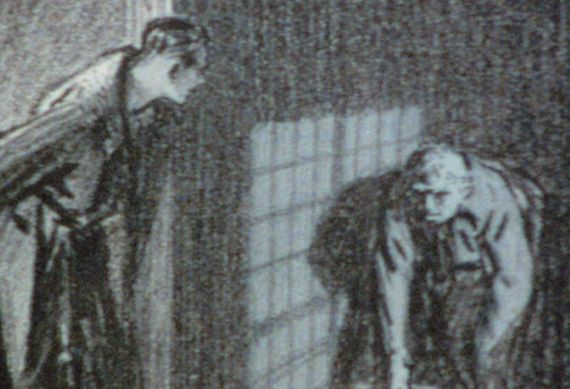
“The Creeping Man” in Hearst’s International, 1923.
Doyle’s Professor Challenger stories opened up the world of science fiction. He travelled as a medic to South Africa and wrote about the Boer War; he produced a six-volume history of World War I. He dabbled in theater (it was the U.S. actor/producer William Gillette who gave Holmes his catchphrase, “Elementary, my dear Watson,” which was taken up by later film producers).
But nothing compared with the popularity of Sherlock Holmes. Eventually, prompted by a need for cash, Doyle cannily dug into Watson’s papers and found a tale “pre-dating” Holmes’s death: The Hound of the Baskervilles was published in 1902. Then, after Collier’s Weekly offered a staggering sum for a series of new stories, Doyle revealed in “The Adventure of the Empty House” how his sleuth had in fact survived Reichenbach after all! Collected short stories followed in The Return of Sherlock Holmes (1905), His Last Bow (1917) and The Case-Book of Sherlock Holmes (1927).
There were problems in Doyle’s private life, too. His wife Louise had been diagnosed with tuberculosis in 1892, and in 1897 the family moved to the fresher air of Surrey and a new home, Under-shaw, at Hindhead. Although he loyally ensured she was cared for, he had fallen in love with a singer, Jean Leckie. Louise died in 1906, Doyle wedded Jean in 1907 and they moved to a house called Windlesham in the Sussex market town of Crowborough, where today an enthusiastic local society promotes his connections and achievements (www.the-conan-doyle-crowborough-establishment.com). The second Doyle marriage produced three children, and he settled into a country gent’s existence.
Throughout his life, Doyle was given to crusades: From defending British conduct in the Boer War (he received a knighthood in recognition of his war services in 1902) to leaping to the defence of private individuals whom he felt had been wrongly treated by the British justice system. In the latter cases, the name of the author of Sherlock Holmes carried weight in the public imagination. He also ran twice (unsuccessfully) for Parliament on a Liberal Unionist ticket.
However, his greatest crusade was to convince the world of his spiritualist beliefs. This is often presented as Doyle turning “dotty” in later life. In fact, he had flirted with the spirit world even in his Southsea days and became fascinated by psychical research, mediums, and séances, all of which he considered an extension of scientific inquiry. It was when Doyle began writing about fairies and touring the world to lecture about spiritualism—including America in 1922—that the public became increasingly perplexed.
Significantly, while Doyle allowed his Professor Challenger to convert to spiritualism in The Land of Mist (1926), he never risked the reputation of his “most perfect reasoning and observing machine.” In “The Sussex Vampire” (1924), Holmes stoutly refutes any supernatural goings-on: “No ghosts need apply.”
Doyle, who had been suffering heart problems, died aged 71, July 7, 1930, sitting in a chair gazing out on his beloved Sussex countryside. Immediately following his death there were reports of increased psychical activity and messages from the departed author. Any such encounters have long since faded, but Sherlock Holmes remains alive and well.
* Originally published in 2009.





Comments